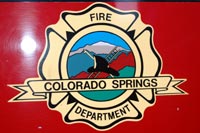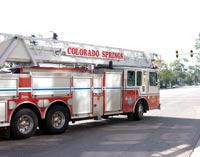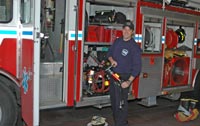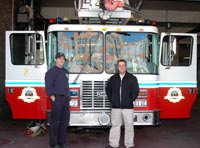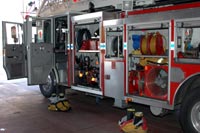| Fire Stations, Fire Museums & RV Fire Safety by Jaimie Hall |
|
If George's son Ian had not gotten married in Colorado in September, we would not have visited the Colorado Springs fire station where he is employed as a firefighter. Ian gave us the full tour, and did I get an education!
Did you know that a fire department somewhere in the U.S. responds to a fire every 20 seconds? The Colorado Springs department's goal is to be on the scene in six minutes or less from the time of the call. Colorado Springs is a paid, municipal fire department with 20 stations. They have five ladder trucks; four have 109 foot ladders. Ian is one of the drivers for the ladder truck at his station. One of the cutting-edge technologies of the department is an in-house GPS mapping system, which controls traffic lights during their response.
The ladder truck is actually an equipment truck. It can be hooked to a hydrant, but it carries no water. Besides the hydraulic ladder operated from the truck, it carries ladders, hoses, exhaust fans, tools, salvage covers, chain saws, Jaws of Life, safety cones and blocks. Ian's four-man ladder crew is cross-trained on the pumper truck.
Station 1 is the oldest station and is scheduled to be replaced soon. Still, it is a home away from home; firefighters work 24 hours on, then 24 off. Upstairs are kitchen, bunk room, showers, office area and meeting room. Only one of the three fire poles is still in use, accessed through an enclosed room to prevent diesel fumes from rising upstairs.
CONSTANT TRAINING
Colorado Springs firefighters must be an EMT or paramedic and attend a 16-week academy. Training in many disciplines is ongoing. Ian and his crewmate Kevin explained they learn and regularly practice swift water rescue, ice rescue, low angle rescue, dealing with hazardous materials, search and rescue, forcible entry, and ventilation in addition to regular firefighting tactics. They continually strive to improve their six-minute response time.
Danger and hazards are many. In fact, though new building construction techniques are stronger, newer houses burn faster and pose more danger for firefighters. In the case of a call to a drug lab, firefighters must don Kevlar and secure the building before the police go in.
MANY TRAVELERS STOP BY
One thing we learned is that quite a few RVers and visitors stop by fire stations. Some stop for directions or to find the best restaurants, but others like to check out the equipment. Some visitors are former firefighters or have relatives who are employees or volunteers in a fire department, while others simply have an interest, perhaps bringing their children or grandchildren to see the station.
There are approximately 30,400 fire departments in the U.S. with about 305,150 career firefighters and about 795,000 volunteers. In addition, there are numerous fire museums, so there are many to see!
RV FIRE SAFETY
Even with all the modern equipment,
if you've ever seen an RV fire, you know that prevention is
the best way to ensure safety. An RV burns so quickly that
unless you can put out a fire immediately at the source, in
minutes, all that is left is metal.
In my ebook The
Woman's Guide to Solo RVing, John Greenlee shares
how their rig caught on fire. John was burned on forty percent
of his body. John has made an incredible recovery and he and
his wife Betty are off traveling again. John's experience
highlights two key warnings to all RVers:
- Respect the dangers of living and working with propane.
- Be sure to know how to operate your fire extinguisher.
RVers should read the article "34
Facts That Can Save Your Life," which can help you
avoid and deal with an RV fire. Two of the important facts
are:
- Save lives first and property second. Get yourself and your family to safety before attempting to extinguish a fire. Only if you can do so without endangering yourself or others should you use firefighting aids on hand.
- It's crucial to know your location so firefighters can find you.
To learn more, consider attending Aon Recreation Insurance's fire and life safety seminar, held at some RV rallies. Check their Web site for more information.
No one wants to call the fire department for a fire, but it is good to know that their equipment and training is available if needed. If you stop by Station 1 in Colorado Springs or another station, be sure to thank the fire fighters for the dangerous job they do.
Jaimie Hall
10/29/06

